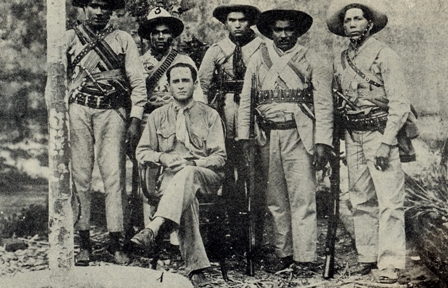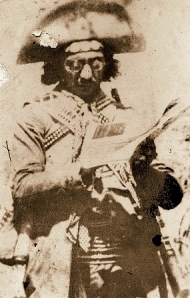
Neco de Pautilia
Publicado no blog Lampião Aceso em 4 de Novembro de 2008
Visitando
Floresta - PE em Julho de 2008 na companhia dos confrades Netinho Nogueira e
Marcelo Rocha tivemos a grata oportunidade de conhecer e conversar com um dos
últimos Nazarenos vivos, o ex comandante de Polícia Manoel Cavalcanti de Souza,
Neco de Pautilia. A satisfação era notadamente mútua, o velho guerreiro se
realiza com cada visita que recebe.
O tempo lhe
cobra tributos, perdeu parte da visão de um dos olhos, apesar da bengala ainda
caminha sem muito esforço, A memória então... é a mesma de grande parte das
testemunhas desta história, até parece que foi ontem, rica em detalhes. No
final do encontro ele lamentou a nossa pressa e nos entregou um texto contendo
o resumo de sua vida e uma homenagem a sua saudosa e inesquecível Nazaré do
Pico.
SERRA DO PICO
“BALIZA DA NOSSA TERRA”
Muitos jovens de Nazaré foram para a Bahia perseguir Lampião e só voltaram depois de dois ou três anos para visitar as famílias, eu estava entre estes.
Chegando em
cima do velho Alto grande do Jatobá, avistamos a Serra do Pico. Apesar de
estarmos voltando desinteirados foi festa com direito a fogos, ou melhor, com
os estampidos dos tiros de fuzil. A Serra do Pico pode ser vista de muito
longe, não sei calcular sua altitude, mas sei que quanto mais longe, mais
bonita e naquele momento quando a avistamos parecia já estarmos em casa, pois
ali é o marco de nossa terra. A alegria foi passageira lembramos que
chegaríamos à Nazaré sem os sete companheiros que ficaram enterrados nas terras
frias do estado de Sergipe, vítimas do tiroteio de Maranduba, em 09
de Janeiro de 1932. Foram estes: Sargento João Cavalcanti, Sargento Hercílio
Nogueira, Adelgício Nogueira, Antonio Benedito, Elias Barbosa, Pedrinho de
Paripiranga e Manoel Boaventura que não resistiu aos ferimentos e veio a
falecer no hospital de Penedo – AL.
Naquela fatídica batalha nos posicionamos em cima de um banco de macambira e os cangaceiros em campo aberto, as baixas do grupo de Lampião foram: Sabonete (secretário de Maria Bonita), Catingueira e Quina-Quina e ainda foram presos Bananeira e Volta Seca. Para sepultar os nossos seis companheiros abrimos covas com ponta de facão, cavador de madeira e um machado velho, e a terra era retirada com as mãos. Eu, Manoel Cavalcanti de Souza participei de seis tiroteios com Lampião os principais foram: no Raso da Catarina com o Tenente Ozório Cordeiro, O fogo da Maranduba- mais notável – e o do Riacho da Guia com o Coronel Liberato e o Sargento Odilon Flor, e mais dois em plena caatinga após os quais pedi baixa já como comandante de um pelotão e voltei a minha terra. Casei-me com uma Alagoana de Pão de açúcar e fixei residência no mesmo estado, foi na cidade de Caboclo que travei meu sexto e último combate com Lampião.
Era costume de ele vingar-se de policiais que antes o haviam perseguido e foi o que aconteceu comigo, através de coiteiros ele tomou conhecimento de nosso paradeiro; cercou nossa barbearia em pleno meio dia de um domingo, houve tiroteio, mas sozinho consegui escapar deixando morto o cangaceiro Pó corante. Como policial dei minha contribuição com muita dignidade aos meus conterrâneos e nunca deixei de cumprir uma ordem dos meus superiores.
Fui agricultor e pecuarista, almocreve, sapateiro, barbeiro, alfaiate e finalmente funcionário público da comissão do Vale do São Francisco de onde só saí aposentado. Nesta companhia uma das atividades que desempenhava era de fazer cobranças e voltando de uma delas na Bahia novamente avistei ao longe Serra do Pico, demorei muito contemplando aquela bonita visão recebendo os raios do sol, tal demora me fez perder a lotação que ia para Floresta, mas essa hora perdida me salvou de uma emboscada fatal. Os tiros que eram pra mim findaram tirando a vida de um outro conterrâneo de Nazaré, O Sr. Tiodomiro Gomes de Sá, no dia 12 de Dezembro de 1970. Sou filho do agricultor e pecuarista Pedro Gregório Ferraz Nogueira e de Pautilia Cavalcanti de Souza, nasci no dia 21 de dezembro de 1912 na Fazenda Ipueira (4° distrito de Floresta) resido atualmente à Rua Manoel Novaes, 42 e me responsabilizo por todas as informações aqui descritas.
Naquela fatídica batalha nos posicionamos em cima de um banco de macambira e os cangaceiros em campo aberto, as baixas do grupo de Lampião foram: Sabonete (secretário de Maria Bonita), Catingueira e Quina-Quina e ainda foram presos Bananeira e Volta Seca. Para sepultar os nossos seis companheiros abrimos covas com ponta de facão, cavador de madeira e um machado velho, e a terra era retirada com as mãos. Eu, Manoel Cavalcanti de Souza participei de seis tiroteios com Lampião os principais foram: no Raso da Catarina com o Tenente Ozório Cordeiro, O fogo da Maranduba- mais notável – e o do Riacho da Guia com o Coronel Liberato e o Sargento Odilon Flor, e mais dois em plena caatinga após os quais pedi baixa já como comandante de um pelotão e voltei a minha terra. Casei-me com uma Alagoana de Pão de açúcar e fixei residência no mesmo estado, foi na cidade de Caboclo que travei meu sexto e último combate com Lampião.
Era costume de ele vingar-se de policiais que antes o haviam perseguido e foi o que aconteceu comigo, através de coiteiros ele tomou conhecimento de nosso paradeiro; cercou nossa barbearia em pleno meio dia de um domingo, houve tiroteio, mas sozinho consegui escapar deixando morto o cangaceiro Pó corante. Como policial dei minha contribuição com muita dignidade aos meus conterrâneos e nunca deixei de cumprir uma ordem dos meus superiores.
Fui agricultor e pecuarista, almocreve, sapateiro, barbeiro, alfaiate e finalmente funcionário público da comissão do Vale do São Francisco de onde só saí aposentado. Nesta companhia uma das atividades que desempenhava era de fazer cobranças e voltando de uma delas na Bahia novamente avistei ao longe Serra do Pico, demorei muito contemplando aquela bonita visão recebendo os raios do sol, tal demora me fez perder a lotação que ia para Floresta, mas essa hora perdida me salvou de uma emboscada fatal. Os tiros que eram pra mim findaram tirando a vida de um outro conterrâneo de Nazaré, O Sr. Tiodomiro Gomes de Sá, no dia 12 de Dezembro de 1970. Sou filho do agricultor e pecuarista Pedro Gregório Ferraz Nogueira e de Pautilia Cavalcanti de Souza, nasci no dia 21 de dezembro de 1912 na Fazenda Ipueira (4° distrito de Floresta) resido atualmente à Rua Manoel Novaes, 42 e me responsabilizo por todas as informações aqui descritas.
Floresta – PE,
20 de Maio de 2002.
http://lampiaoaceso.blogspot.com.br













